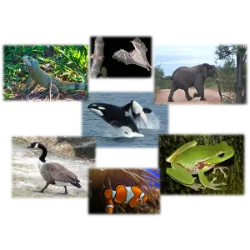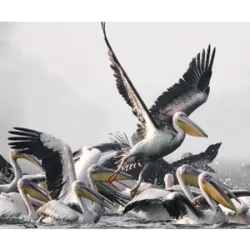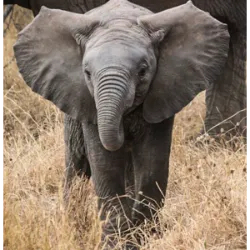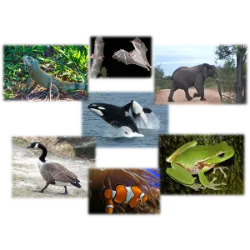The Masters of Life Between Water and Earth

Amphibians, a fascinating group of vertebrate animals, are true survivors that move between the aquatic and terrestrial world. Composed of toads, frogs, tree frogs, salamanders and caecilians, this group plays a crucial role in ecosystems and is highlighted in studies on evolution and adaptation.
Unique Features
They have thin, moist, permeable skin, which makes them highly dependent on moist environments to survive. This special skin not only protects, but also allows cutaneous respiration, complementing lung respiration. During the larval stage, they generally breathe through gills and live exclusively in water, while adults migrate to dry land, adapting with lungs and strong legs to jump or swim.
Ecological Importance
These animals are important environmental indicators. Because they are sensitive to changes in the environment, their presence (or absence) warns about the health of ecosystems. Additionally, amphibians control insect populations, including agricultural pests and disease carriers such as mosquitoes.
Survival Challenges
Amphibians face serious threats such as deforestation, pollution, climate change and fungal diseases such as chytridiomycosis.
Vertebrate Animals

Meet the Protagonists of Animal Life
They are one of the most fascinating groups in the animal kingdom, bringing together creatures with spinal columns and a sophisticated central nervous system. This group includes five broad categories: fish, amphibians, reptiles, birds and mammals.
Who Are the Vertebrates?
These animals' main characteristic is the presence of a vertebral column, which protects the spinal cord and provides support to the body. Furthermore, they have an internal skeleton that allows a wide variety of movements and adaptations, in addition to complex systems, such as the circulatory, digestive and nervous systems.
Fish are the pioneers among vertebrates and live exclusively in aquatic environments. Amphibians, such as toads and frogs, divide their lives between water and land, while reptiles have conquered drier environments thanks to their scaly skin. Birds dominated the skies with light feathers and bones, while mammals, which include humans, stand out for their parental care and ability to regulate their body temperature.
Importance
Vertebrates are fundamental to the balance of ecosystems, controlling populations of prey and predators, pollinating plants and dispersing seeds.
Test yourself with one of these challenges 👇
Discover some interesting facts about Vertebrate Animals
The First Vertebrates to Dominate the Oceans

Fish were one of the oldest groups among vertebrate animals, they are the true pioneers of life with a spinal column. These fascinating inhabitants of aquatic environments represent an enormous diversity of shapes, sizes and ways of life, playing fundamental roles in marine and freshwater ecosystems.
Distinctive Characteristics
Fish have hydrodynamic bodies, covered in scales, and use their gills to breathe underwater. Its fin system allows efficient movement, while the swim bladder, present in many species, helps control buoyancy.
Divided into two large groups:
Cartilaginous fish: such as sharks and rays, with skeletons made of cartilage rather than bone.
Bony fish: such as sardines, salmon and tilapia, which have calcified bone skeletons.
Ecological and Economic Importance
These vertebrates are essential for the balance of aquatic ecosystems. They control populations of other species, contribute to nutrient cycling, and serve as a food source for marine animals and humans. Furthermore, fish are one of the main sources of protein for billions of people in the world, driving fishing and aquaculture industries.
The Pathfinders of Life in Dry Environments

Reptiles, a group of vertebrate animals that includes snakes, alligators, turtles and lizards, are known for their incredible ability to adapt to the most varied environments, especially drier ones. With an evolution that dates back millions of years, these animals play fundamental roles in terrestrial and aquatic ecosystems.
Main Features
They have skin covered in tough scales or plates, which protect them against water loss and predators. They are ectothermic animals, that is, they depend on external heat to regulate their body temperature, which explains their habit of "sunbathing".
They breathe exclusively through lungs and, for the most part, reproduce through eggs with hard shells, resistant to drying out. This characteristic allowed them to colonize environments where other vertebrates could not survive.
Diversity and Curiosities
Snakes: They are highly adapted predators, capable of swallowing prey whole thanks to flexible jaws.
Alligators and crocodiles: These are semi-aquatic reptiles, known for their strength and parental behavior — they care for their young.
Turtles: They inhabit terrestrial environments, fresh or salt water.
Lizards: With species ranging from small geckos to large Komodo dragons.
The Birds: The Kings of the Skies

A fascinating group of vertebrate animals, they are recognized for their ability to fly, colorful feathers and melodious songs. From sparrows and penguins to eagles and toucans, these animals are found in almost every corner of the planet, playing essential roles in terrestrial and aquatic ecosystems.
Features:
One of the main characteristics of birds is the presence of feathers, which help them both in flight and in regulating body temperature. Their streamlined body, light, hollow bones and powerful muscles make flight possible in most species.
Other traits include:
Beaks adapted to food, which vary according to the diet of each species (insects, seeds, fruits, meat, etc.).
Reproduction through eggs with rigid shells, protecting the embryos against drying out.
They are endotherms ("warm-blooded"), which allows them to maintain a constant body temperature, even in cold environments.
Ecological Importance
Pollination: Hummingbirds and other species help spread flower pollen.
Seed dispersal: When they feed on fruits, they spread seeds that help regenerate forests.
Pest control: Many birds, such as owls, feed on insects and rodents, balancing populations.
The Closest Group to Humans

Mammals, one of the most fascinating groups of vertebrate animals, stand out for their unique characteristics, such as the presence of hair and the ability to feed their young with breast milk. With species ranging from small rodents to giants such as the blue whale, they are fundamental to the balance of terrestrial, aquatic and aerial ecosystems.
Striking Features
Mammals have some exclusive characteristics that differentiate them from other vertebrates:
Presence of hair: Protects against the cold and helps with camouflage.
Mammary glands: They produce milk to nourish puppies in the first stages of life.
Endothermy: They are "warm-blooded", keeping their body temperature stable in different environments.
Highly developed nervous system, with large brains that enable complex behaviors such as learning and communication.
Mammal Diversity:
Mammals are divided into three large groups:
Monotremes: Mammals that lay eggs, such as the platypus.
Marsupials: Cubs are born prematurely and complete their development in the kangaroo (pouch), like kangaroos.
Placentals: Most mammals, including dogs, elephants and humans, have longer gestations and more developed offspring.
Role in the Ecosystem.
Test yourself with one of these challenges 👇
HOME














